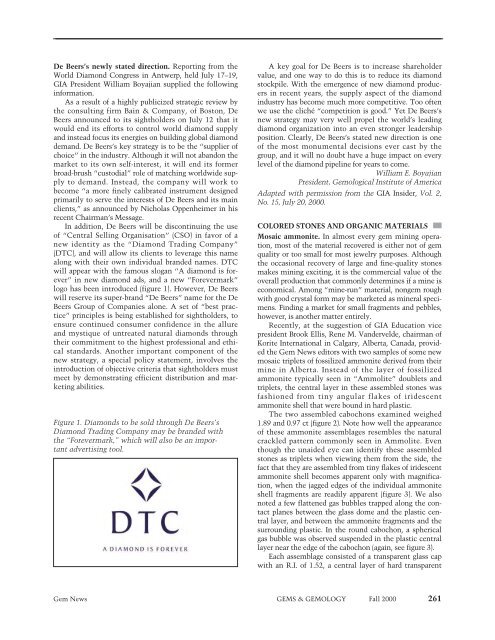Fall 2000 Gems & Gemology - Gemfrance
Fall 2000 Gems & Gemology - Gemfrance
Fall 2000 Gems & Gemology - Gemfrance
Create successful ePaper yourself
Turn your PDF publications into a flip-book with our unique Google optimized e-Paper software.
De Beers’s newly stated direction. Reporting from the<br />
World Diamond Congress in Antwerp, held July 17–19,<br />
GIA President William Boyajian supplied the following<br />
information.<br />
As a result of a highly publicized strategic review by<br />
the consulting firm Bain & Company, of Boston, De<br />
Beers announced to its sightholders on July 12 that it<br />
would end its efforts to control world diamond supply<br />
and instead focus its energies on building global diamond<br />
demand. De Beers’s key strategy is to be the “supplier of<br />
choice” in the industry. Although it will not abandon the<br />
market to its own self-interest, it will end its former<br />
broad-brush “custodial” role of matching worldwide supply<br />
to demand. Instead, the company will work to<br />
become “a more finely calibrated instrument designed<br />
primarily to serve the interests of De Beers and its main<br />
clients,” as announced by Nicholas Oppenheimer in his<br />
recent Chairman’s Message.<br />
In addition, De Beers will be discontinuing the use<br />
of “Central Selling Organisation” (CSO) in favor of a<br />
new identity as the “Diamond Trading Company”<br />
(DTC), and will allow its clients to leverage this name<br />
along with their own individual branded names. DTC<br />
will appear with the famous slogan “A diamond is forever”<br />
in new diamond ads, and a new “Forevermark”<br />
logo has been introduced (figure 1). However, De Beers<br />
will reserve its super-brand “De Beers” name for the De<br />
Beers Group of Companies alone. A set of “best practice”<br />
principles is being established for sightholders, to<br />
ensure continued consumer confidence in the allure<br />
and mystique of untreated natural diamonds through<br />
their commitment to the highest professional and ethical<br />
standards. Another important component of the<br />
new strategy, a special policy statement, involves the<br />
introduction of objective criteria that sightholders must<br />
meet by demonstrating efficient distribution and marketing<br />
abilities.<br />
Figure 1. Diamonds to be sold through De Beers’s<br />
Diamond Trading Company may be branded with<br />
the “Forevermark,” which will also be an important<br />
advertising tool.<br />
A key goal for De Beers is to increase shareholder<br />
value, and one way to do this is to reduce its diamond<br />
stockpile. With the emergence of new diamond producers<br />
in recent years, the supply aspect of the diamond<br />
industry has become much more competitive. Too often<br />
we use the cliché “competition is good.” Yet De Beers’s<br />
new strategy may very well propel the world’s leading<br />
diamond organization into an even stronger leadership<br />
position. Clearly, De Beers’s stated new direction is one<br />
of the most monumental decisions ever cast by the<br />
group, and it will no doubt have a huge impact on every<br />
level of the diamond pipeline for years to come.<br />
William E. Boyajian<br />
President, Gemological Institute of America<br />
Adapted with permission from the GIA Insider, Vol. 2,<br />
No. 15, July 20, <strong>2000</strong>.<br />
COLORED STONES AND ORGANIC MATERIALS<br />
Mosaic ammonite. In almost every gem mining operation,<br />
most of the material recovered is either not of gem<br />
quality or too small for most jewelry purposes. Although<br />
the occasional recovery of large and fine-quality stones<br />
makes mining exciting, it is the commercial value of the<br />
overall production that commonly determines if a mine is<br />
economical. Among “mine-run” material, nongem rough<br />
with good crystal form may be marketed as mineral specimens.<br />
Finding a market for small fragments and pebbles,<br />
however, is another matter entirely.<br />
Recently, at the suggestion of GIA Education vice<br />
president Brook Ellis, Rene M. Vandervelde, chairman of<br />
Korite International in Calgary, Alberta, Canada, provided<br />
the Gem News editors with two samples of some new<br />
mosaic triplets of fossilized ammonite derived from their<br />
mine in Alberta. Instead of the layer of fossilized<br />
ammonite typically seen in “Ammolite” doublets and<br />
triplets, the central layer in these assembled stones was<br />
fashioned from tiny angular flakes of iridescent<br />
ammonite shell that were bound in hard plastic.<br />
The two assembled cabochons examined weighed<br />
1.89 and 0.97 ct (figure 2). Note how well the appearance<br />
of these ammonite assemblages resembles the natural<br />
crackled pattern commonly seen in Ammolite. Even<br />
though the unaided eye can identify these assembled<br />
stones as triplets when viewing them from the side, the<br />
fact that they are assembled from tiny flakes of iridescent<br />
ammonite shell becomes apparent only with magnification,<br />
when the jagged edges of the individual ammonite<br />
shell fragments are readily apparent (figure 3). We also<br />
noted a few flattened gas bubbles trapped along the contact<br />
planes between the glass dome and the plastic central<br />
layer, and between the ammonite fragments and the<br />
surrounding plastic. In the round cabochon, a spherical<br />
gas bubble was observed suspended in the plastic central<br />
layer near the edge of the cabochon (again, see figure 3).<br />
Each assemblage consisted of a transparent glass cap<br />
with an R.I. of 1.52, a central layer of hard transparent<br />
Gem News GEMS & GEMOLOGY <strong>Fall</strong> <strong>2000</strong> 261


